1999 TOYOTA LAND CRUISER trailer
[x] Cancel search: trailerPage 84 of 202

New L/C100(U)
92
The gauge indicates the engine coolant
temperature when the ignition switch is
on. The engine operating temperature
will vary with changes in weather and
engine load.
If the needle points to the red zone or
higher, stop your vehicle and allow the
engine to cool.
Your vehicle may overheat during severe
operating conditions, such as: � Driving up a long hill on a hot day.
� Reducing speed or stopping after high
speed driving.
� Idling for a long period with the air
conditioning on in stop- and- go traffic.
� Towing a trailer.
NOTICE
�Do not remove the thermostat in
the engine cooling system as thismay cause the engine to overheat.The thermostat is designed to con-
trol the flow of coolant to keep thetemperature of the engine withinthe specified operating range.
�Do not continue driving with anoverheated engine. See ºIf your ve-hicle overheatsº in Part 4.
Oil pressure gauge
Idling
Normal driving
The oil pressure gauge indicates engine
oil pressure when the ignition switch is
on. Check it while driving to make sure
that the needle is in the proper range.
If the oil pressure should stay below the
normal range, pull off the road to a safe
place and stop the engine immediately.
Call a Toyota dealer or qualified repair
shop for assistance.
Oil pressure may not build up when the
oil level is too low. The oil pressure
gauge is not designed to indicate oil level,
and the oil level must be checked using
the level dipstick.
Engine coolant temperature
gauge
Page 94 of 202
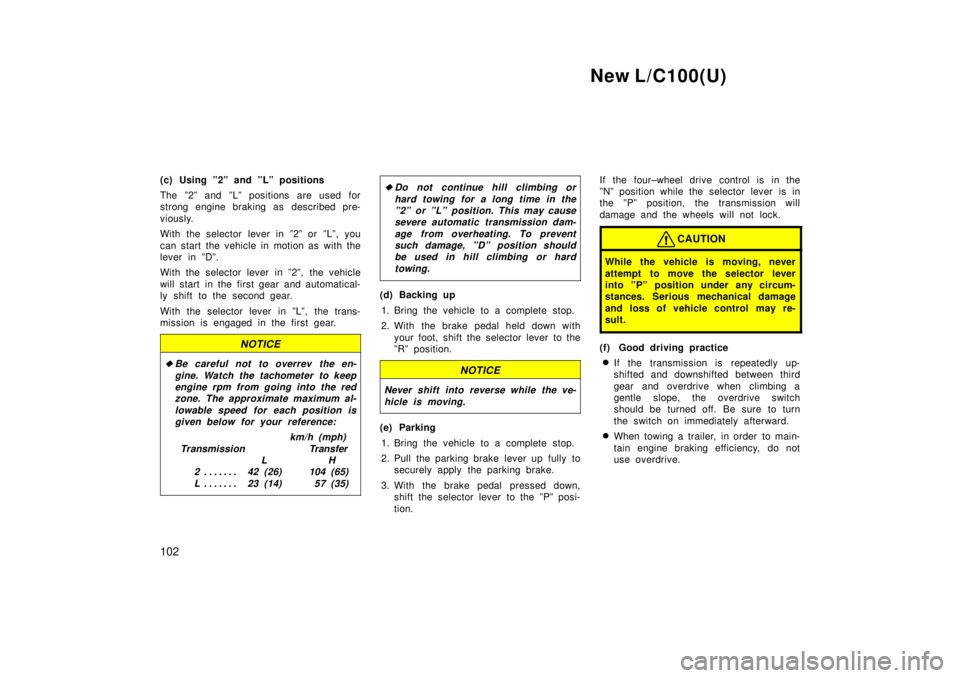
New L/C100(U)
102
(c) Using º2º and ºLº positions
The º2º and ºLº positions are used for
strong engine braking as described pre-
viously.
With the selector lever in º2º or ºLº, you
can start the vehicle in motion as with the
lever in ºDº.
With the selector lever in º2º, the vehicle
will start in the first gear and automatical-
ly shift to the second gear.
With the selector lever in ºLº, the trans-
mission is engaged in the first gear.
NOTICE
�Be careful not to overrev the en-
gine. Watch the tachometer to keepengine rpm from going into the red zone. The approximate maximum al-
lowable speed for each position isgiven below for your reference:
km/h (mph)
Transmission Transfer L H
2 42 (26) 104 (65) . . . . . . .
L 23 (14) 57 (35) . . . . . . .
�Do not continue hill climbing or
hard towing for a long time in theº2º or ºLº position. This may causesevere automatic transmission dam-
age from overheating. To preventsuch damage, ºDº position shouldbe used in hill climbing or hard
towing.
(d) Backing up
1. Bring the vehicle to a complete stop.
2. With the brake pedal held down with your foot, shift the selector lever to the
ºRº position.
NOTICE
Never shift into reverse while the ve-
hicle is moving.
(e) Parking
1. Bring the vehicle to a complete stop.
2. Pull the parking brake lever up fully to securely apply the parking brake.
3. With the brake pedal pressed down, shift the selector lever to the ºPº posi-
tion. If the four±wheel drive control is in the
ºNº position while the selector lever is in
the ºPº position, the transmission will
damage and the wheels will not lock.
CAUTION
While the vehicle is moving, never
attempt to move the selector lever
into ºPº position under any circum-
stances. Serious mechanical damage
and loss of vehicle control may re-
sult.
(f) Good driving practice
� If the transmission is repeatedly up-
shifted and downshifted between third
gear and overdrive when climbing a
gentle slope, the overdrive switch
should be turned off. Be sure to turn
the switch on immediately afterward.
� When towing a trailer, in order to main-
tain engine braking efficiency, do not
use overdrive.
Page 144 of 202
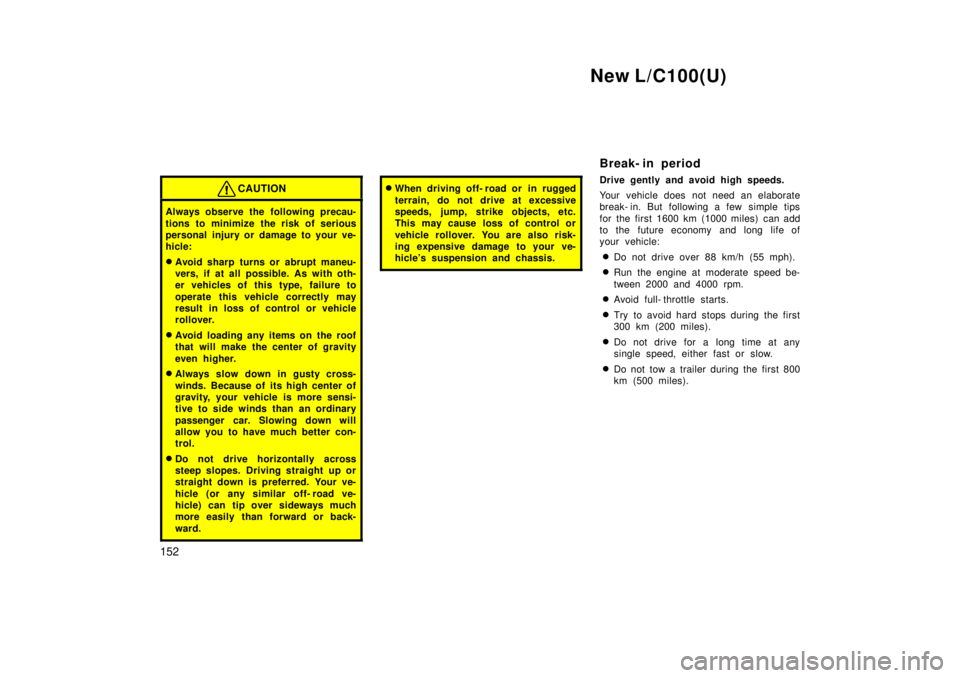
New L/C100(U)
152
CAUTION
Always observe the following precau-
tions to minimize the risk of serious
personal injury or damage to your ve-
hicle: � Avoid sharp turns or abrupt maneu-
vers, if at all possible. As with oth-
er vehicles of this type, failure to
operate this vehicle correctly may
result in loss of control or vehicle
rollover.
� Avoid loading any items on the roof
that will make the center of gravity
even higher.
� Always slow down in gusty cross-
winds. Because of its high center of
gravity, your vehicle is more sensi-
tive to side winds than an ordinary
passenger car. Slowing down will
allow you to have much better con-
trol.
� Do not drive horizontally across
steep slopes. Driving straight up or
straight down is preferred. Your ve-
hicle (or any similar off- road ve-
hicle) can tip over sideways much
more easily than forward or back-
ward.
�When driving off- road or in rugged
terrain, do not drive at excessive
speeds, jump, strike objects, etc.
This may cause loss of control or
vehicle rollover. You are also risk-
ing expensive damage to your ve-
hicle's suspension and chassis.
Break- in period
Drive gently and avoid high speeds.
Your vehicle does not need an elaborate
break- in. But following a few simple tips
for the first 1600 km (1000 miles) can add
to the future economy and long life of
your vehicle:
� Do not drive over 88 km/h (55 mph).
� Run the engine at moderate speed be-
tween 2000 and 4000 rpm.
� Avoid full- throttle starts.
� Try to avoid hard stops during the first
300 km (200 miles).
� Do not drive for a long time at any
single speed, either fast or slow.
� Do not tow a trailer during the first 800
km (500 miles).
Page 164 of 202
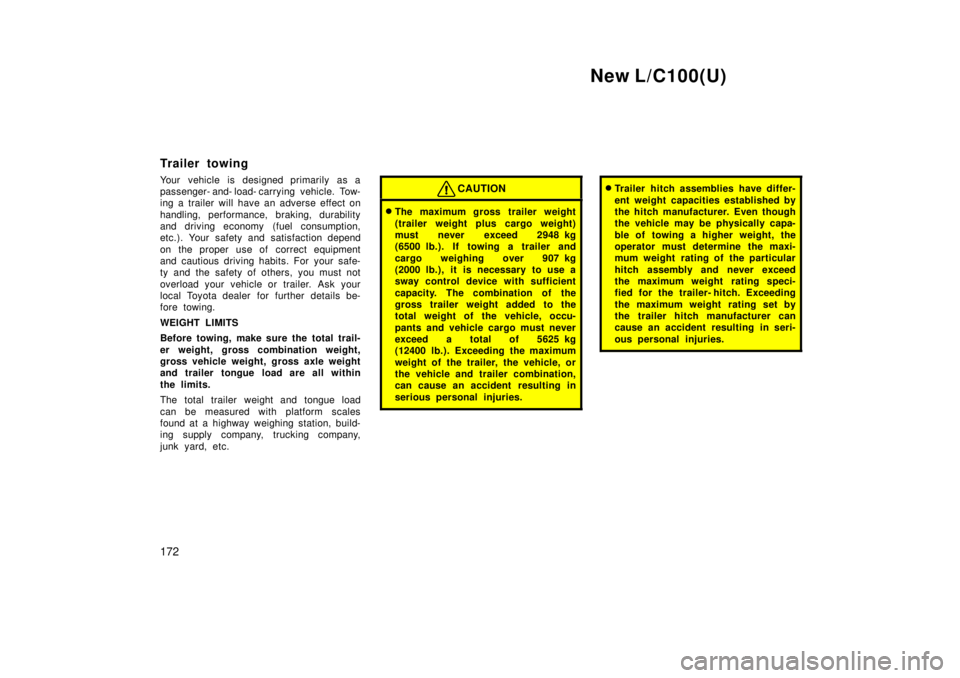
New L/C100(U)
172
Trailer towing
Your vehicle is designed primarily as a
passenger- and- load- carrying vehicle. Tow-
ing a trailer will have an adverse effect on
handling, performance, braking, durab
ility
and driving economy (fuel consumption,
etc.). Your safety and satisfaction depend
on the proper use of correct equipment
and cautious driving habits. For your safe-
ty and the safety of others, you must not
overload your vehicle or trailer. Ask your
local Toyota dealer for further details be-
fore towing.
WEIGHT LIMITS
Before towing, make sure the total trail-
er weight, gross combination weight,
gross vehicle weight, gross axle weight
and trailer tongue load are all within
the limits.
The total trailer weight and tongue load
can be measured with platform scales
found at a highway weighing station, build-
ing supply company, trucking company,
junk yard, etc.
CAUTION
� The maximum gross trailer weight
(trailer weight plus cargo weight)
must never exceed 2948 kg
(6500 lb.). If towing a trailer and
cargo weighing over 907 kg
(2000 lb.), it is necessary to use a
sway control device with sufficient
capacity. The combination of the
gross trailer weight added to the
total weight of the vehicle, occu-
pants and vehicle cargo must never
exceed a total of 5625 kg
(12400 lb.). Exceeding the maximum
weight of the trailer, the vehicle, or
the vehicle and trailer combination,
can cause an accident resulting in
serious personal injuries.
�Trailer hitch assemblies have differ-
ent weight capacities established by
the hitch manufacturer. Even though
the vehicle may be physically capa-
ble of towing a higher weight, the
operator must determine the maxi-
mum weight rating of the particular
hitch assembly and never exceed
the maximum weight rating speci-
fied for the trailer- hitch. Exceeding
the maximum weight rating set by
the trailer hitch manufacturer can
cause an accident resulting in seri-
ous personal injuries.
Page 165 of 202
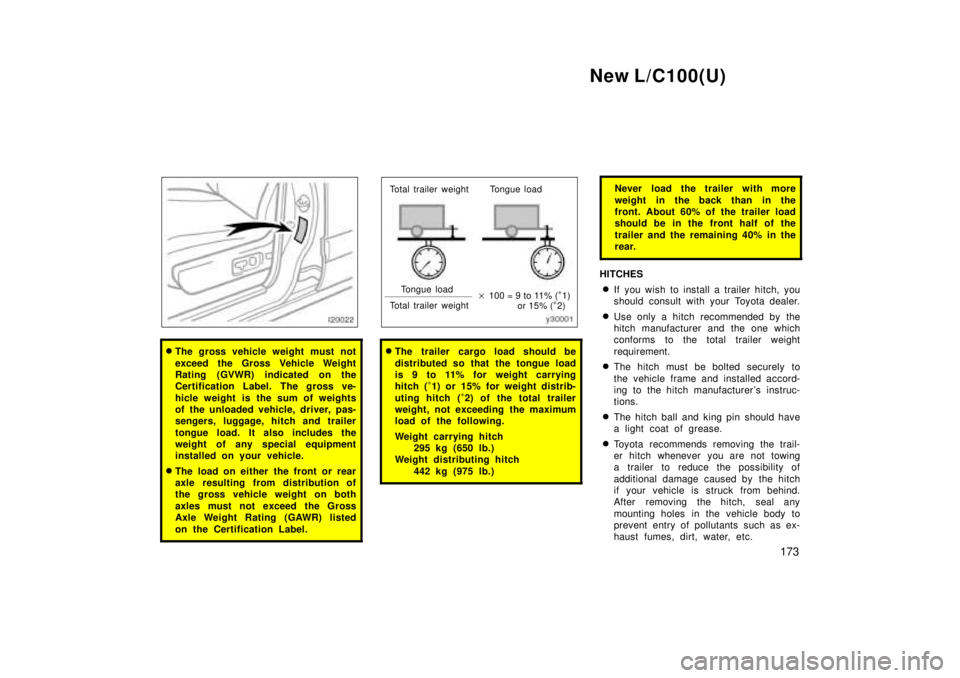
New L/C100(U)173
�The gross vehicle weight must not
exceed the Gross Vehicle Weight
Rating (GVWR) indicated on the
Certification Label. The gross ve-
hicle weight is the sum of weights
of the unloaded vehicle, driver, pas-
sengers, luggage, hitch and trailer
tongue load. It also includes the
weight of any special equipment
installed on your vehicle.
� The load on either the front or rear
axle resulting from distribution of
the gross vehicle weight on both
axles must not exceed the Gross
Axle Weight Rating (GAWR) listed
on the Certification Label.
Total trailer weight Tongue load
Tongue load
Total trailer weight �
100 = 9 to 11% ( *
1)
or 15% ( *
2)
� The trailer cargo load should be
distributed so that the tongue load
is 9 to 11% for weight carrying
hitch ( *
1) or 15% for weight distrib-
uting hitch ( *
2) of the total trailer
weight, not exceeding the maximum
load of the following.
Weight carrying hitch 295 kg (650 lb.)
Weight distributing hitch
442 kg (975 lb.)
Never load the trailer with more
weight in the back than in the
front. About 60% of the trailer load
should be in the front half of the
trailer and the remaining 40% in the
rear.
HITCHES
� If you wish to install a trailer hitch, you
should consult with your Toyota dealer.
� Use only a hitch recommended by the
hitch manufacturer and the one which
conforms to the total trailer weight
requirement.
� The hitch must be bolted securely to
the vehicle frame and installed accord-
ing to the hitch manufacturer 's instruc-
tions.
� The hitch ball and king pin should have
a light coat of grease.
� Toyota recommends removing the trail-
er hitch whenever you are not towing
a trailer to reduce the possib ility of
additional damage caused by the hitch
if your vehicle is struck from behind.
After removing the hitch, seal any
mounting holes in the vehicle body to
prevent entry of pollutants such as ex-
haust fumes, dirt, water, etc.
Page 166 of 202
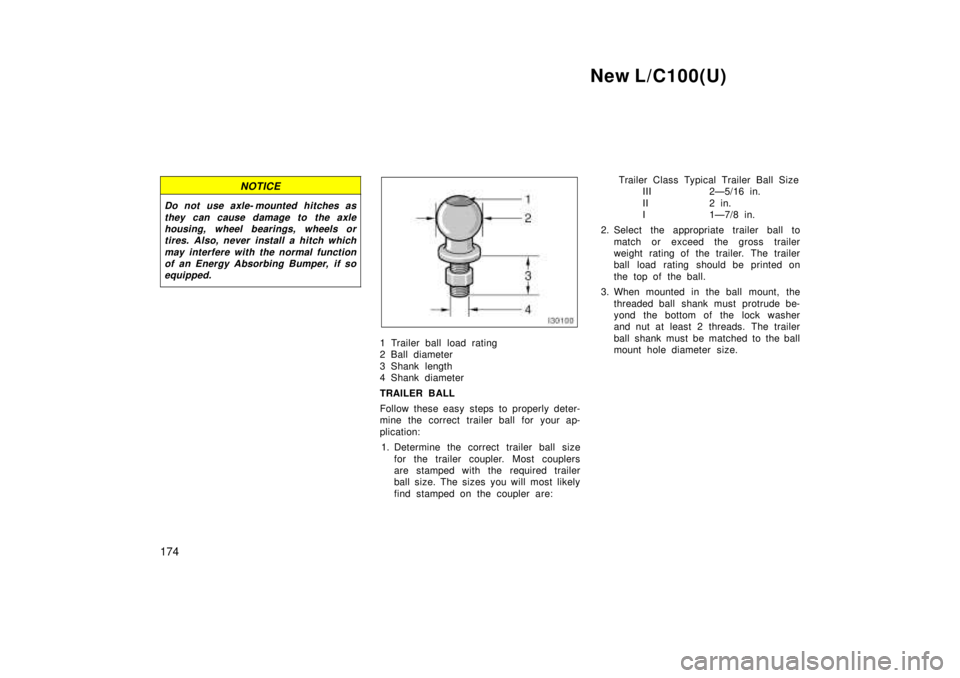
New L/C100(U)
174
NOTICE
Do not use axle- mounted hitches as they can cause damage to the axlehousing, wheel bearings, wheels ortires. Also, never install a hitch which
may interfere with the normal functionof an Energy Absorbing Bumper, if soequipped.
1 Trailer ball load rating
2 Ball diameter
3 Shank length
4 Shank diameter
TRAILER BALL
Follow these easy steps to properly deter-
mine the correct trailer ball for your ap-
plication:
1. Determine the correct trailer ball size for the trailer coupler. Most couplers
are stamped with the required trailer
ball size. The sizes you will most likely
find stamped on the coupler are: Trailer Class Typical Trailer Ball Size
III 2Ð5/16 in.
II 2 in. I1 Ð7/8 i n.
2. Select the appropriate trailer ball to match or exceed the gross trailer
weight rating of the trailer. The trailer
ball load rating should be printed on
the top of the ball.
3. When mounted in the ball mount, the threaded ball shank must protrude be-
yond the bottom of the lock washer
and nut at least 2 threads. The trailer
ball shank must be matched to the ball
mount hole diameter size.
Page 167 of 202
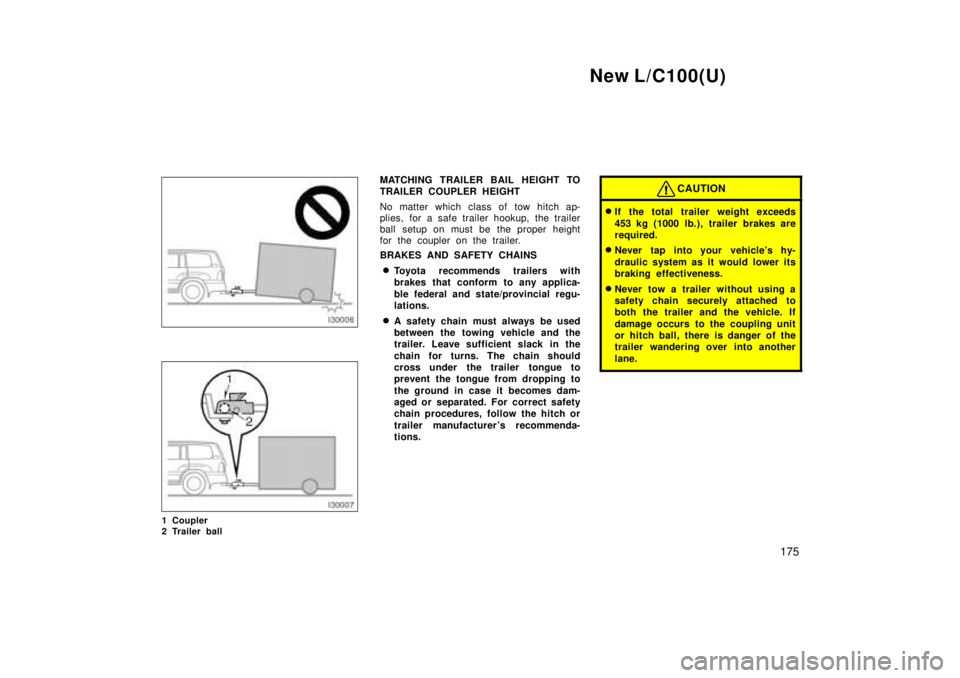
New L/C100(U)175
1 Coupler
2 Trailer ball MATCHING TRAILER BAIL HEIGHT TO
TRAILER COUPLER HEIGHT
No matter which class of tow hitch ap-
plies, for a safe trailer hookup, the trailer
ball setup on must be the proper height
for the coupler on the trailer.
BRAKES AND SAFETY CHAINS
� Toyota recommends trailers with
brakes that conform to any applica-
ble federal and state/provincial regu-
lations.
� A safety chain must always be used
between the towing vehicle and the
trailer. Leave sufficient slack in the
chain for turns. The chain should
cross under the trailer tongue to
prevent the tongue from dropping to
the ground in case it becomes dam-
aged or separated. For correct safety
chain procedures, follow the hitch or
trailer manufacturer 's recommenda-
tions.
CAUTION
�If the total trailer weight exceeds
453 kg (1000 lb.), trailer brakes are
required.
� Never tap into your vehicle's hy-
draulic system as it would lower its
braking effectiveness.
� Never tow a trailer without using a
safety chain securely attached to
both the trailer and the vehicle. If
damage occurs to the coupling unit
or hitch ball, there is danger of the
trailer wandering over into another
lane.
Page 168 of 202

New L/C100(U)
176
TIRES
� Ensure that your vehicle's tires are
properly inflated. Adjust the tire pres-
sure indicated below:
Tire pressure, kPa (kgf/cm 2
or bar, psi)
Front 220 (2.2, 32)
Rear 240 (2.4, 35)
� The trailer tires should be inflated to
the pressure recommended by the trail-
er manufacturer in respect to the total
trailer weight.
TRAILER LIGHTS � Trailer lights must comply with federal,
state/provincial and local regulations.
See your local recreational vehicle
dealer or rental agency for the correct
type of wiring and relays for your trail-
er. Check for correct operation of the
turn signals and stop lights each time
you hitch up. Direct splicing may dam-
age your vehicle's electrical system
and cause a malfunction of your lights.
BREAK- IN SCHEDULE
� Toyota recommends that you do not
tow a trailer with a new vehicle or a
vehicle with any new power train com-
ponent (engine, transmission, differen-
tial, wheel bearing, etc.) for the first
800 km (500 miles) of driving. MAINTENANCE
� If you tow a trailer, your vehicle will
require more frequent maintenance due
to the additional load. For this
information, please refer to the
scheduled maintenance information in
the ºScheduled Maintenance Guideº or
ºOwner 's Manual Supplementº.
� Retighten all fixing bolts of the towing
ball and bracket after approximately
1000 km (600 miles) of trailer driving.
PRE- TOWING SAFETY CHECK � Check that your vehicle remains level
when a loaded or unloaded trailer is
hitched. Do not drive if the vehicle has
an abnormal nose- up or nose- down
condition, and check for improper
tongue load, overload, worn suspension
or other possible causes.
� Make sure the trailer cargo is securely
loaded so that it cannot shift.
� Check that your rear view mirrors con-
form to any applicable federal, state/
provincial or local regulation. If not,
install the rear view mirrors required
for towing purpose. TRAILER TOWING TIPS
When towing a trailer, your vehicle will
handle differently than when not tow-
ing. The three main causes of vehicle-
trailer accidents are driver error, exces-
sive speed and improper trailer loading.
Keep these in mind when towing:
� Before starting out, check operation of
the lights and all vehicle- trailer connec-
tions. After driving a short distance,
stop and recheck the lights and con-
nections. Before actually towing a trail-
er, practice turning, stopping and back-
ing with a trailer in an area away from
traffic until you learn the feel.
� Because stopping distance may be in-
creased, vehicle- to- vehicle distance
should be increased when towing a
trailer. For each 16 km/h (10 mph) of
speed, allow at least one vehicle and
trailer length between you and the ve-
hicle ahead. Avoid sudden braking as
you may skid, resulting in jackknifing
and loss of control. This is especially
true on wet or slippery surfaces.